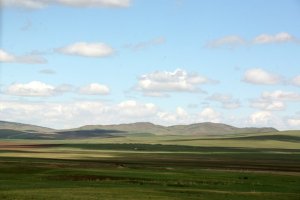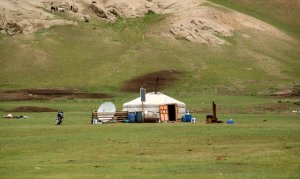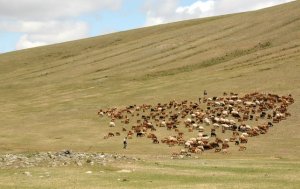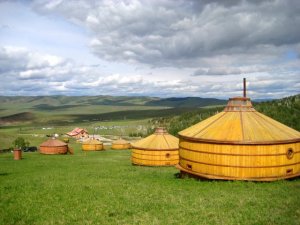
The Mongolian Steppe
Lest any gentle reader take offense at my views on the Mongolian capital (and one comment-leaver did mightily, but at least he/she loaded the vitriol with one of my favorite words — „puerile” – points for that), I’ve decided to wrap up my Mongolia blog series (short as it may be) on a more positive note. No, I am not caving in to a bad review (freedom of speech, baby!), but actually, once you get out of the fairly hellish hole of Ulaanbaatar, the country is transformed – visually, at least. (There’s a slide show below.)
Escape we did, on the weekend between the two weeks of the course, aided by two Australian women who were doing a year’s Peace Corps-like work at the Press Institute where we were teaching. Incredibly friendly in that very Aussie way, we’d asked them for some advice on where to go for a couple of days in the country. Next thing we knew, they had set everything up, arranged a driver, reserved some huts in a yurt camp, and are buying food and lots of beer for a planned picnic on Saturday. We just had to show up.
Hitting the road Saturday morning in a minivan, we left the prefab facades of UB behind, then drove though the informal settlements that are popping up all around the capital as people from the countryside flock to the city — tending their traditional flocks isn’t cutting it for a lot of Mongolians financially anymore. Many bring their traditional homes with them, the white, circular felt tents known as yurts, or gers in Mongolian.

Ger with satellite dish and solar panel
It seems a poor tradeoff to my untrained eye, giving up the austere beauty of the Mongolian countryside for the squalor of a crowded outlying neighborhood of UB. But then again, I might opt for some city living after years of isolated living on the steppe, when temps drop to -40 degrees in the winter and the prices I’m getting for my sheep continues to plummet. That romanticism would also likely die a quick death from frost bite after a few late-night trips to the outdoor pit toilet.
But, hey, I was just there for the weekend, so I feel free indulge in some purely aesthetic appreciation – and there’s a lot of wonder at. After the last gas station on the outskirts of UB falls behind, the landscape opens up, long stretches of rolling green grassland with low mountains in the background that appear to go on forever. It’s the largeness of it all that’s most remarkable — especially the sky, which overpowers the land below and which on this weekend was roiling with cloud formations in advance and retreat.
It’s a largely empty land – about two-and-a-half times the size of Texas, but with a population of only 2.7 million. We passed through one town on the way to our destination, but otherwise you pretty much just spy the occasional ger or ger group from the road, a herd of horses or flock of sheep, and, well, that’s about it.

Revenue Source (Photo: Marc Seidel)
The road leading up to our ger camp was pretty good; it had been repaved by the government due to the mining operations nearby. But at one point we veered off onto a dirt path and, yes, even in this almost deserted landscape, almost managed to hit another car head-on in a Mongolian game of off-road chicken.
Disaster averted, we arrived at the Secret History Ger Camp. I think the Secret History part refers to an early Mongolian literary/historical work – but it pretty much remained secretive to us. The place was kind of upscale for a ger camp. No white felt tents for the tourists, no ma’am, these were wooden. The main house had a restaurant, masseurs, and a karaoke room, which was often in use. (Mongolians love karaoke.) Still, the gers themselves were just one room structures, no plumbing inside, and a stove in the middle with a box beside it filled with wood and dung for heating.
All in all, a good time, enjoying a few beers and a picnic amid the grandeur of the landscape, watching sheep head served in the restaurant, moving the party into the ger at night amid the warm heat of the dung-fed fire (it doesn’t really stink). This camp was surrounded by hills that actually had trees – a rare treat.

Luxury Gers
The hotel staff would come out at night and get the fire started for you and you’d keep it going as you fell asleep. In some places, the Aussies told us, personnel come into your ger again at 4 a.m. to restart it, which I imagine could be disconcerting. In our case, they didn’t, although I wish they had. I woke up at about 6:30 just freezing – the temps had really dipped over the weekend. I made it over to the phone with my Mongolian guide book phrase section shivering in my hand.
Got someone from the main house and started scanning the entries…no word for “fire” here, only “Please hold the dogs!” and “I hope your animals are fattening up nicely.”
Finally, there it was: “stove” (zuukh), so I yelled that into the bad line and the number of our ger. They seemed to get what I meant. I was quite proud, although no one ever knocked on our door. Turns out, I’d said “two” instead of “three” just sent the fire lighters to the Australians’ ger.
Well, I was awake by then, and decided I might as well take a morning walk. Once out into the bracing air, I noticed a big mangy dog eyeing me warily. Remembering that phrase I’d just passed by in the guide book, I made a wide circle around him on my way toward the far horizon.